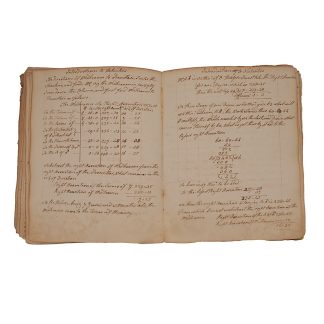[LILLY, William, PARTRIDGE, John, after].
ENGLISH ASTROLOGER’S NOTEBOOK
[English Astrological MS]
Manuscript, on paper, England, [mid- to third quarter of the 18th century]£2,750.00
Small 4to. 123 unnumbered ll., 12 blank. English MS, in brown ink, cursive hand, approx. 25 lines per page, Britannia watermark with countermark WD, outer margins single ink ruled, occasional numerical tables. A few early and final ll. a bit soiled, couple of lower outer corners frayed, light water stain or thumb mark to some lower margins, softened in places. A well-preserved ms. in contemporary vellum, single blind ruled, dust-soiled, repairs to lower edges, and head and foot of spine, upper cover vellum creased. Loose C18 ms. paper slip with inventory, further inventories (one dated 1819) to three ll., ms. ‘Octob 19, 1810 Mr Bagtham’ to rear pastedown.
A well-preserved, mysterious English ms. on judicial astrology—the fascinating relic of a provincial amateur’s engagement with what was, by the late C18, an art in decline, eventually eradicated by Victorian occultism. The orderly layout, clear handwriting and plain binding suggest these were notes taken for private study. During the decline spanning the first half of the C18, astrology had come to be closely associated with a ‘scandalous’ art and forms of ‘quack’ medicine, so much so that practitioners did not associate themselves publicly with their studies. It thus lost the prestige it had enjoyed in the C17 as a discipline per se, when it elicited the interest of scholars like Newton and Boyle. ‘There are definitely some facets of the art which had fully disappeared by the 1720s but which in the last decades of the C18 emerged again. Of fundamental importance […] was the revival of works […] intended to teach the art of astrology to those unversed in it. After 1780 these works started to be published and distributed again, demonstrating that the art had again achieved enough public prominence among the literate to cause some to be interested in learning its practice’ (Clements, 117). Among these was ‘The Young Student’s Guide in Astrology’ (1785) by George Mensforth, who wrote it because he was ‘sensible of the great difficulty of obtaining books of good authors on […] Astrology (and those at a very high price when met with)’.
This ms. notebook was clearly produced to obviate to this scarcity—no earlier than the mid-C18 (as per watermark) but before the 1780s revival. The author i.a. painstakingly transcribed over 200pp., many from vols 1 and 3 of ‘Christian Astrology’ (1647) by the famous William Lilly (1602-81), with additional excerpts from ‘Defectio Geniturarum’ (1697) by John Partridge (1644-1714), a most prominent and controversial astrologer c.1700. Lilly and Partridge were practitioners with business premises and a wide-ranging clientele, and were much requested for horoscopes; their almanacs also advertised their medical treatments. The focus of the notebook is on nativities (horoscopes) and judicial astrology, with detailed methods to calculate ‘the effects of Directions, Revolutions, Profections, and Transits’, and discussing ‘those generall Accidents which in a natural course depend upon the signification of the 12 Houses of Heaven’. The author engaged critically with late C17 debates on horoscopes, inserting passages from Partrige’s ‘Defectio Geniturarum’ (1697), which epitomised the latter’s critical change of mind concerning traditional horoscope methodology. Selected excerpts from Lilly include theories and calculations of directions (the occurrence of good or bad accidents, e.g., predictions of the best time to marry or a time of danger and death); profections (the prioritization of specific planetary transits, their projected advancement and consequences thereof); bodily infirmities (weak sight, ‘defects in the ears’, ‘impediments of the tongue’, kidney conditions, ‘madness’, stones, gout); family fortunes (how many servants, how much cattle); and predictions on future travels.
In 1810-19, this notebook was being used by a London merchant to register accounts for the sale of hay and coal, in a tentative spelling, to a Mary Huxley, a Mr Graves and a Mr Bagtham.
J. Clements, ‘The intellectual and social declines of alchemy and astrology, c.1650-1720’ (unpublished PhD, University of York, 2017).In stock


![[LILLY, William, PARTRIDGE, John, after].](https://sokol.co.uk/wp-content/uploads/2020/07/IMG_7904.jpg)
![[LILLY, William, PARTRIDGE, John, after]. - Image 2](https://sokol.co.uk/wp-content/uploads/2020/07/Untitled-22-1.jpg)
![[LILLY, William, PARTRIDGE, John, after]. - Image 3](https://sokol.co.uk/wp-content/uploads/2020/07/Untitled-24-1.jpg)
![[LILLY, William, PARTRIDGE, John, after]. - Image 4](https://sokol.co.uk/wp-content/uploads/2020/07/Untitled-25-1.jpg)
![[LILLY, William, PARTRIDGE, John, after]. - Image 5](https://sokol.co.uk/wp-content/uploads/2020/07/Untitled-26-1.jpg)
![[LILLY, William, PARTRIDGE, John, after]. - Image 6](https://sokol.co.uk/wp-content/uploads/2020/07/Untitled-27.jpg)
![[LILLY, William, PARTRIDGE, John, after]. - Image 7](https://sokol.co.uk/wp-content/uploads/2020/07/Untitled-28.jpg)
![[LILLY, William, PARTRIDGE, John, after]. - Image 8](https://sokol.co.uk/wp-content/uploads/2020/07/Untitled-29-5.jpg)
